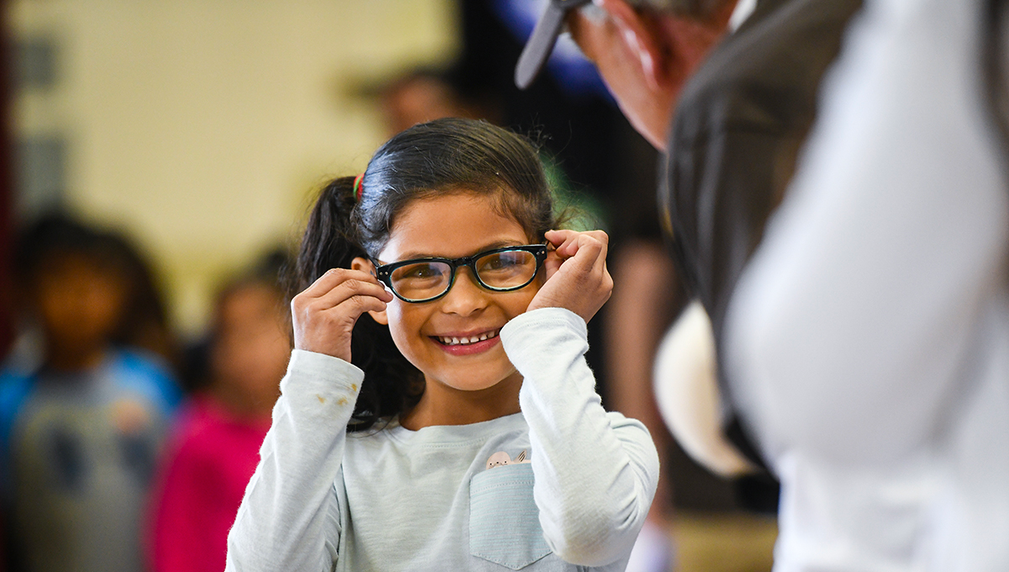Eyeglasses Fuel Student Success in STEAM!
How can students succeed in STEAM if they have poor vision? Though 1 in 4 children naturally need glasses, 95% in underserved areas do not have them, including an estimated 250,000 children in Los Angeles. With 2050 funding, Vision To Learn (VTL) would provide 500 eye exams and 400 prescription glasses for LA children in need. Children in under resourced communities have fallen far behind academically during the pandemic. VTL is a proven intervention to enable them to catch up.

What is the primary issue area that your application will impact?
K-12 STEAM Education
In which areas of Los Angeles will you be directly working?
Central LA
East LA
San Gabriel Valley
San Fernando Valley
South LA
West LA
South Bay
Antelope Valley
County of Los Angeles
City of Los Angeles
In what stage of innovation is this project, program, or initiative?
Expand existing project, program, or initiative
What is your understanding of the issue that you are seeking to address?
Students with uncorrected vision avoid reading, suffer headaches, and have trouble focusing on class, as 80% of their learning is visual. These children are more likely to fail a grade, and less likely to read by 3rd grade – a milestone critical to preventing dropout. Up to 70% of those in the juvenile legal system have uncorrected vision problems. The need is urgent, as the pandemic has caused significant learning loss. More than 200,000 LA students are not meeting grade-level goals in math and reading – foundations of STEAM learning. The pandemic exacerbated systemic achievement gaps. Children of color experienced greater stress and their schools and families had less resources for distance learning. Last week, a 2nd grader received his glasses. He was so excited to try them out that he ran towards the word wall in the classroom. Stopping 10 feet away from the wall, he began to read the words aloud, twirled, and whispered, “I can see.”
Describe the project, program, or initiative this grant will support to address the issue.
Vision care at school overcomes systemic barriers to access such as parents’ inability to take time off from work, misunderstanding about need and cost of vision care, lack of quality vision care providers in underserved neighborhoods, and high transportation costs. Vision To Learn' overcomes these access barriers by bringing exams and glasses directly to students at school. Vision To Learn is building a reimbursement process to obtain public support for our program through Medicaid and thus will serve as a groundbreaking model for bringing health care directly to schools sustainably supported by public reimbursement. VTL’s Screening and Examination process is: 1. VTL schedules and performs vision screenings using a Welch Allyn Spot Vision Screener, to determine which students have vision difficulties. All students are screened, regardless of insurance or citizenship status. 2. VTL’s mobile clinic comes to the school, where trained opticians and optometrists conduct eye exams for every student who fails their vision screening. 3. If students need glasses, they choose a frame from a wide selection on the clinic. Glasses are delivered approximately three weeks later. 4. If a child loses/breaks their glasses within one year, VTL replaces them free of charge. 5. VTL returns every two years to provide continuity of care at schools.
Describe how Los Angeles County will be different if your work is successful.
With this grant, Vision To Learn (VTL) would complete 1,500 vision screenings, 500 eye exams, and provide 400 prescription glasses for students who would otherwise struggle to see the board, participate in class, or benefit from a STEAM curriculum. Johns Hopkins Wilmer Eye Institute completed a study on the impact of our work, published (9/21) in JAMA Ophthalmology. This study demonstrated that students with glasses made higher gains in reading and math, at levels exceeding the gains of other far more expensive common educational interventions like charter schools, extended school days, or one-on-one technology. In fact, on average, students made additional gains on the level that would be expected from adding an additional two to four months of class time. UCLA Mattel Children’s Hospital found that children provided glasses can be expected to show improvements in math and reading, higher self-esteem and better class participation.
What evidence do you have that this project, program, or initiative is or will be successful, and how will you define and measure success?
VTL has provided over 1.5 million vision screenings, 380,000 eye exams and 306,000 glasses at over 4,190 sites nationwide – removing an important barrier to success with STEAM for hundreds of thousands of children. VTL measures the number of students provided vision care by tracking vision screenings, exams, glasses, and vision correction in a secure, cloud-based Electronic Medical Records (EMR) database, updated in real time by optometric staff in our mobile clinics. VTL’s EMR tracks results by student, mobile clinic, school district, and geographic area, allowing us to report program successes due to the LA 2050 program. A recent Johns Hopkins/Wilmer Eye Institute 3-year controlled study has shown that students recovered significant learning time due to VTL’s program as measured by standardized test results. This is critical to closing the learning gap that has emerged with the pandemic.
Approximately how many people will be impacted by this project, program, or initiative?
Direct Impact: 500
Indirect Impact: 1,500